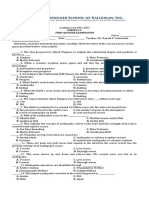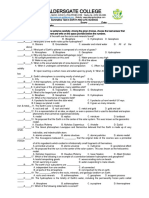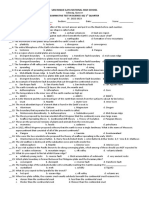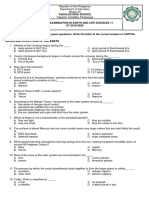0 ratings0% found this document useful (0 votes)
20 viewsGrade 10 Science 1st Quarter Exam
Grade 10 Science 1st Quarter Exam
Uploaded by
Michaelle Bunao1. The document is a science exam from Accelerated Learning Academy for their first quarter examination on science 10.
2. It contains 30 multiple choice questions testing knowledge of earth science topics like plate tectonics, earthquakes, volcanoes, and the layers of the earth.
3. It also has sections to fill in information about the lithosphere, hydrosphere, and atmosphere.
Copyright:
© All Rights Reserved
Available Formats
Download as DOC, PDF, TXT or read online from Scribd
Grade 10 Science 1st Quarter Exam
Grade 10 Science 1st Quarter Exam
Uploaded by
Michaelle Bunao0 ratings0% found this document useful (0 votes)
20 views3 pages1. The document is a science exam from Accelerated Learning Academy for their first quarter examination on science 10.
2. It contains 30 multiple choice questions testing knowledge of earth science topics like plate tectonics, earthquakes, volcanoes, and the layers of the earth.
3. It also has sections to fill in information about the lithosphere, hydrosphere, and atmosphere.
Original Title
359112895 Grade 10 Science 1st Quarter Exam
Copyright
© © All Rights Reserved
Available Formats
DOC, PDF, TXT or read online from Scribd
Share this document
Did you find this document useful?
Is this content inappropriate?
1. The document is a science exam from Accelerated Learning Academy for their first quarter examination on science 10.
2. It contains 30 multiple choice questions testing knowledge of earth science topics like plate tectonics, earthquakes, volcanoes, and the layers of the earth.
3. It also has sections to fill in information about the lithosphere, hydrosphere, and atmosphere.
Copyright:
© All Rights Reserved
Available Formats
Download as DOC, PDF, TXT or read online from Scribd
Download as doc, pdf, or txt
0 ratings0% found this document useful (0 votes)
20 views3 pagesGrade 10 Science 1st Quarter Exam
Grade 10 Science 1st Quarter Exam
Uploaded by
Michaelle Bunao1. The document is a science exam from Accelerated Learning Academy for their first quarter examination on science 10.
2. It contains 30 multiple choice questions testing knowledge of earth science topics like plate tectonics, earthquakes, volcanoes, and the layers of the earth.
3. It also has sections to fill in information about the lithosphere, hydrosphere, and atmosphere.
Copyright:
© All Rights Reserved
Available Formats
Download as DOC, PDF, TXT or read online from Scribd
Download as doc, pdf, or txt
You are on page 1of 3
ACCELERATED LEARNING ACADEMY INC.
“Right Education…Bright Future…”
Nambalan Sta. Ignacia, Tarlac
FIRST QUARTER EXAMINATION
SCIENCE 10
NAME: _______________________________ SCORE: _____________________
GRADE &SECTION: ______________________ DATE: ______________________
________1. fic Ring of fire of known as ___________.
A. earthquake C. tsunami
B. folding D. fault ________2. When Earth’s crust
bends, forces act towards each other, this phenomenon may result to:
A. earthquake C. tsunami
B. folding D. faulting
________3. When the Earth’s crust cracks and tension forms or develops, this
phenomenon is called:
A. earthquake C. tsunami
B. folding D. faulting
________4. The supercontinent called Pangaea was believed to exist ____ million years
ago.
A. 120 C. 200
B. 100 D. 300
________5. The Earth is estimated to be around 4.6 billion years old, this data was
based from:
A. the presence of heat in the earth’s core C. the amount of gases in the
atmosphere
B. record of earthquake on Earth D. rock and fossils record
________6. 80% of all earthquakes occur in the __________________.
A. Atlantic Belt C. Mediterranean-Asiatic
Belt
B. Caribbean Belt D. Pacific Belt
________7.Tsunamis are big waves that are caused by:
A. Strong winds C. earthquake or volcano eruption on
land
B. Cyclones D. underwater earthquake or volcanic
eruption
________8. Earthquake epicentres are identified through __________________.
A. Richter Scaling C. Triangulation Method
B. Seismographic Method D. Scaling Method
________9. The largest earthquake recorded in the world happened in ______________.
A. Alaska C. USA
B. Chile D. Japan
________10. The point on Earth's surface directly above the focus of an earthquake is
the ____.
A. focus C. fault
B. epicenter D. inner core
________11. Convection currents are identified Earth's __________.
A. continents C. mantle
B. inner core D. lithosphere
________12. A boundary where plates move away from each other is called:
A. divergent C. transform
B. convergent D. shear
________13. A deep crack in the earth’s surface is called a :
A. ridge C. fold
B. plate D. fault
________14. How does the plates move at a transform boundary?
A. they move toward each other C. they move past each other
B. they move away from each other D. they do not move
________15. A boundary where plates bump from each other is called:
A. divergent boundary C. transform boundary
B. shear boundary D. convergent boundary
________16. What kind of plate boundary results to the formation of most volcanoes?
A. divergent boundary C. transform boundary
B. shear boundary D. convergent boundary
________17. What kind of plate boundary results to the formation of San Andreas
fault?
A. divergent boundary C. transform boundary
B. shear boundary D. convergent boundary
________18. When magma reaches the earth’s surface, it is called:
A. rock C. lava
B. magma D. caldera
________19. The very large, bowl-shaped depression on top of a volcano due to
eruption is called a:
A. peak C. crater/caldera
B. ridge D. vent
________20. The highest mountain in the Philippines is _______________.
A. Mount Kilauea C. Mount Mayon
B. Mount Apo D. Mount Arayat
________21. The outer core is made up of:
A. solid iron and nickel C. solid iron and aluminum
B. liquid iron and nickel D. liquid iron and aluminum
________22. The thickest layer of the earth is__________.
A. inner core . C. mantle
B. crust D. outer core
________23. The most abundant element in the earth’s crust is:
A. carbon C. iron
B. oxygen D. silicon
________24. The inside of the Earth consists of four major layers. Which is the hottest
layer?
A. inner core C. mantle
B. crust D. outer core
________25. The order of the layers from the inside of the Earth outward is:
A. inner core, outer core, mantle, crust C. inner core, outer core, crust,
mantle
B. outer core, inner core, mantle, crust D. mantle, inner core, outer
core, crust
________26. The thinnest layer of the earth is the:
A. inner core C. mantle
B. crust D. outer core
________27. Subduction is:
A. where denser plates sink into the mantle
B. where ridge valleys form
C. occurring mostly in the Atlantic Ocean
D. occurring where continental plates diverge
________28. What are the two type of crust?
A. thick and thin C. ocean and basin
B. continental and oceanic D. lower and upper
________29. The science that deals with the history of the earth and its life especially
as recorded rocks.
A. Astronomy C. Volcanology
B. Biology D. Geology
________30. It is a violent shaking of the earth’s surface that are caused by sudden
release of stored rocks.
A. Tsunami C. Earthquake
B. Cyclone D. Geology
Lithosphere Hydrosphere Atmosphere
1. 1. 1.
2. 2. 2.
3. 3. 3.
4.
Prepared by: Checked by: Noted by:
MICHAELLE J. BUNAO RUEL NAVAROZA JESUS BULOSAN
Teacher . SCHOOL HEAD SCHOOL ADMINISTRATOR
You might also like
- Grade 10 Science 1st Quarter ExamDocument4 pagesGrade 10 Science 1st Quarter ExamNeptune Lopez86% (210)
- Earth and Life Science 1st Quarter Exam DRAFTDocument5 pagesEarth and Life Science 1st Quarter Exam DRAFTBillones Rebalde Marnelle100% (11)
- Snicker LabDocument2 pagesSnicker Labapi-285795135No ratings yet
- G10-Prelim EamDocument3 pagesG10-Prelim EamJohnie Rey VillaruzNo ratings yet
- g10 Prelim EamDocument3 pagesg10 Prelim EamJohnie Rey VillaruzNo ratings yet
- Grade 10 Science 1st Quarter ExamDocument3 pagesGrade 10 Science 1st Quarter ExamCharizza Cabrera100% (1)
- SUMMATIVE TEST IN SCIENCE 6 (Fourth Quarter)Document3 pagesSUMMATIVE TEST IN SCIENCE 6 (Fourth Quarter)Cindy Mae Macamay100% (2)
- 1st PT Sci 10grade 10.'24-'25Document2 pages1st PT Sci 10grade 10.'24-'25Roshiel NacionNo ratings yet
- Science 10 1st Quarter ExamDocument3 pagesScience 10 1st Quarter ExamRonald ValenzuelaNo ratings yet
- Science 10 1st Quarter ExamDocument3 pagesScience 10 1st Quarter ExamRonald Valenzuela50% (2)
- 1st-Qtr-Exam Sci 10Document3 pages1st-Qtr-Exam Sci 10Rachel CapiñanesNo ratings yet
- Q1 Periodic Test in Science 10Document4 pagesQ1 Periodic Test in Science 10Jezha Mae Nelmida75% (4)
- Science 9 KeyDocument5 pagesScience 9 KeyRPONTEJONo ratings yet
- Gigaquit National School of Home Industries: Gigaquit, Surigao Del NorteDocument6 pagesGigaquit National School of Home Industries: Gigaquit, Surigao Del NorteAlexie AlmohallasNo ratings yet
- g10 Periodical TestDocument4 pagesg10 Periodical TestSHIELLA MALANOGNo ratings yet
- Test 2 in Science 4th QuarterDocument3 pagesTest 2 in Science 4th Quarter114853No ratings yet
- Grade 6Document4 pagesGrade 6Dharel Joy AbongNo ratings yet
- Long Test in Science 10 Quarter 1Document2 pagesLong Test in Science 10 Quarter 1MARIA THEA CALAGUASNo ratings yet
- First Quarterly Test: Earth & Life ScienceDocument10 pagesFirst Quarterly Test: Earth & Life Scienceglaiza abucayNo ratings yet
- StudentsDocument4 pagesStudentsAlexie AlmohallasNo ratings yet
- MULTIPLE CHOICE. in Each Item, Choose The Letter of The Option That Correctly Answers TheDocument3 pagesMULTIPLE CHOICE. in Each Item, Choose The Letter of The Option That Correctly Answers ThesophiaNo ratings yet
- Summative Test 3 Grade 10 Plate Boundaries Module 4Document3 pagesSummative Test 3 Grade 10 Plate Boundaries Module 4Joanabel DechosaNo ratings yet
- Banban National High School Science 10Document4 pagesBanban National High School Science 10robert valdezNo ratings yet
- Summative Test-EALS (1st Quarter)Document3 pagesSummative Test-EALS (1st Quarter)Cassidy Zapanta100% (2)
- Schools Division Office - Malabon City Tinajeros National High SchoolDocument2 pagesSchools Division Office - Malabon City Tinajeros National High SchoolMaryrose VillanuevaNo ratings yet
- When God Is Y0ur Reas0n To Live, You Will Never Have A Reas0n To QuitDocument3 pagesWhen God Is Y0ur Reas0n To Live, You Will Never Have A Reas0n To QuitOlive Ann Dizon-Bautista100% (1)
- 3rd Quarter SummativeDocument3 pages3rd Quarter Summativerhenz marie cadelinia germanNo ratings yet
- Department of Education Catandaan-Yabut National High SchoolDocument3 pagesDepartment of Education Catandaan-Yabut National High SchoolRaymond BugagaoNo ratings yet
- Science 9 Q3 Summative FinalDocument3 pagesScience 9 Q3 Summative FinalHarri PalacioNo ratings yet
- Summative Test in Science 9 3rdDocument2 pagesSummative Test in Science 9 3rdNerlyn OlegarioNo ratings yet
- Social 8Document3 pagesSocial 8bogartshitu09No ratings yet
- 1st QuarterDocument5 pages1st QuarterlindyNo ratings yet
- 1st Grading Exam Science Grade 10Document2 pages1st Grading Exam Science Grade 10Ann Necdote100% (2)
- Summative Test in Science 6 Q4Document6 pagesSummative Test in Science 6 Q4Isil Albina100% (1)
- 1st Periodical Test in Science 10 2024Document2 pages1st Periodical Test in Science 10 2024ronabel.sollerNo ratings yet
- 3rd Quarter Science 9 ExamDocument12 pages3rd Quarter Science 9 ExamJOEL JACOBNo ratings yet
- Earth Science FINAL EXAMDocument2 pagesEarth Science FINAL EXAMMary Jane Tamondong BaniquedNo ratings yet
- 2 Summative Test in Science Grade 10: San Pedro Integrated SchoolDocument2 pages2 Summative Test in Science Grade 10: San Pedro Integrated SchoolDennisNo ratings yet
- Grade-10-Science-Q1 SUMMATIVE TESTDocument2 pagesGrade-10-Science-Q1 SUMMATIVE TESTNhet Ytienza100% (11)
- PT Earth and Life Science Q1Document5 pagesPT Earth and Life Science Q1Mika Jade BaddalNo ratings yet
- 1st Periodical Test G10Document5 pages1st Periodical Test G10Ivy Joy DaguitNo ratings yet
- Science10 1st-QuarterDocument4 pagesScience10 1st-QuarterAljazer AbbasNo ratings yet
- Science 10 Quarter ExamDocument5 pagesScience 10 Quarter ExamlorenzfloresNo ratings yet
- Summative Test in Volcanoes Q3Document20 pagesSummative Test in Volcanoes Q3angel pranadaNo ratings yet
- Grade 6 Exam (Sci)Document4 pagesGrade 6 Exam (Sci)Karene DegamoNo ratings yet
- Summative Test in Science 6 W 1& 2 Q4Document3 pagesSummative Test in Science 6 W 1& 2 Q4ThelNo ratings yet
- SCIENCE GRADE 6 QuestionsDocument11 pagesSCIENCE GRADE 6 QuestionsIZ Sandy JoyceNo ratings yet
- Summative Test - First QuarterDocument8 pagesSummative Test - First Quartercristito inovalNo ratings yet
- Summative Test - First QuarterDocument5 pagesSummative Test - First Quartercristito inovalNo ratings yet
- Set CDocument3 pagesSet CjonaTOTNo ratings yet
- 4th PER EX Sci 6Document4 pages4th PER EX Sci 6Benson CornejaNo ratings yet
- Midterm Exam EarthDocument5 pagesMidterm Exam EarthMarilyn RonquilloNo ratings yet
- Summative Test 4 Grade 10 Possible Causes and Evidences Module 5 and 6Document4 pagesSummative Test 4 Grade 10 Possible Causes and Evidences Module 5 and 6Joanabel DechosaNo ratings yet
- Science10 Summative TestDocument4 pagesScience10 Summative TestESTHER MAE ANN TRUGILLO100% (1)
- 1st Quarter Long TestDocument5 pages1st Quarter Long TestDixie FinchNo ratings yet
- 1st PT Science 10Document3 pages1st PT Science 10Jonash MacaloodNo ratings yet
- First Quarter SCI 10Document5 pagesFirst Quarter SCI 10bryanNo ratings yet
- Science 10: Department of Education Division of Oriental Mindoro Puerto Galera Nhs Dulangan ExtensionDocument3 pagesScience 10: Department of Education Division of Oriental Mindoro Puerto Galera Nhs Dulangan ExtensionJennifer MagangoNo ratings yet
- Science 10Document3 pagesScience 10Windy C. RomeroNo ratings yet
- Ar 2024Document3 pagesAr 2024Michaelle BunaoNo ratings yet
- Certificate 2022Document7 pagesCertificate 2022Michaelle BunaoNo ratings yet
- Math LeastDocument10 pagesMath LeastMichaelle BunaoNo ratings yet
- Ultratech Smart Pen CJDocument8 pagesUltratech Smart Pen CJMichaelle BunaoNo ratings yet
- School ActivityDocument3 pagesSchool ActivityMichaelle BunaoNo ratings yet
- Proiject FastDocument26 pagesProiject FastMichaelle BunaoNo ratings yet
- Certificate of AppearanceDocument2 pagesCertificate of AppearanceMichaelle BunaoNo ratings yet
- School Site Development PlanDocument2 pagesSchool Site Development PlanMichaelle BunaoNo ratings yet
- Computing Test Statistic Value Involving Population ProportionDocument15 pagesComputing Test Statistic Value Involving Population ProportionMichaelle BunaoNo ratings yet
- Resignation LetterDocument1 pageResignation LetterMichaelle BunaoNo ratings yet
- Certificate of AppearanceDocument1 pageCertificate of AppearanceMichaelle BunaoNo ratings yet
- Memo MeetingDocument33 pagesMemo MeetingMichaelle BunaoNo ratings yet
- Summative TestDocument8 pagesSummative TestMichaelle BunaoNo ratings yet
- Swapping LetterDocument14 pagesSwapping LetterMichaelle BunaoNo ratings yet
- Cert EnrolmentDocument4 pagesCert EnrolmentMichaelle BunaoNo ratings yet
- Leave FormDocument2 pagesLeave FormMichaelle BunaoNo ratings yet
- Week 3 Math 7Document11 pagesWeek 3 Math 7Michaelle BunaoNo ratings yet
- DRRM Week 3Document4 pagesDRRM Week 3Michaelle BunaoNo ratings yet
- The Interior Structure of The Earth Is Layered in Spherical ShellsDocument2 pagesThe Interior Structure of The Earth Is Layered in Spherical ShellsKumar SripathmanathanNo ratings yet
- What To Do Before, During and After EarthquakeDocument25 pagesWhat To Do Before, During and After EarthquakeChenielyn AlboriaNo ratings yet
- Geotechnical Core Logging Manual - 20120420 - SRKDocument5 pagesGeotechnical Core Logging Manual - 20120420 - SRKVictor Manuel UribeNo ratings yet
- Earthquakes and Volcanoes The Restless Earth PDFDocument121 pagesEarthquakes and Volcanoes The Restless Earth PDFAri Yusliandi50% (2)
- Mapping The Ring of Fire - Student Handout - AccessDocument4 pagesMapping The Ring of Fire - Student Handout - AccessBilly STOJANOVSKINo ratings yet
- Earthquake Zones of India - Wikipedia ReferenceDocument18 pagesEarthquake Zones of India - Wikipedia ReferenceDurga Prasad SharmaNo ratings yet
- Hall - 2000 Neogene Collision Halmahera Region-DikonversiDocument8 pagesHall - 2000 Neogene Collision Halmahera Region-DikonversiNursonia MesirNo ratings yet
- A Virtual Journey To The Earth's Center: Sheryl BraileDocument35 pagesA Virtual Journey To The Earth's Center: Sheryl Brailejawad khanNo ratings yet
- (1990) - Stratabound Ore Deposits in The AndesDocument812 pages(1990) - Stratabound Ore Deposits in The AndesKevin Espinoza AsisNo ratings yet
- Geo DPQ 2Document11 pagesGeo DPQ 2annalaanvithaNo ratings yet
- D3R - Module-4 - 2ND Sem - 2ND Quarter - Grade-11 - Stem-Del-Pilar - Stem-Malvar - Mr.-Arnold-PaombongDocument15 pagesD3R - Module-4 - 2ND Sem - 2ND Quarter - Grade-11 - Stem-Del-Pilar - Stem-Malvar - Mr.-Arnold-PaombongArnold Arada PaombongNo ratings yet
- The Windimurra Igneous Complex, Yilgarn Craton: An Archean Layered Intrusion Revealed by Seismic Data and 3D ModellingDocument34 pagesThe Windimurra Igneous Complex, Yilgarn Craton: An Archean Layered Intrusion Revealed by Seismic Data and 3D ModellingValentina Renza PinoNo ratings yet
- Pacific Ring of Fire EssayDocument3 pagesPacific Ring of Fire EssayleonielainecolbornNo ratings yet
- RubricDocument4 pagesRubricapi-291725689No ratings yet
- Endogenic Processes ReviewerDocument4 pagesEndogenic Processes ReviewerMariz Abigail NaorbeNo ratings yet
- MagmatismDocument15 pagesMagmatismCisca Noda RafusonNo ratings yet
- Folds and FaultsDocument2 pagesFolds and FaultsFatima OlendanNo ratings yet
- Complete Your Responses in A Color Other Than Black or Red.: Homework 7-Igneous Rocks and VolcanoesDocument3 pagesComplete Your Responses in A Color Other Than Black or Red.: Homework 7-Igneous Rocks and VolcanoesGil GameshNo ratings yet
- What Is Geology?: The Science of GeologyDocument18 pagesWhat Is Geology?: The Science of GeologyNada serine ZouaneNo ratings yet
- GorontaloDocument4 pagesGorontaloBeng BengNo ratings yet
- Keynote Ias Geography Optional P-1 MaterialDocument55 pagesKeynote Ias Geography Optional P-1 Materialkarthik kNo ratings yet
- Earthquake and Faults QuizDocument1 pageEarthquake and Faults QuizMARISTELA MACARANASNo ratings yet
- History of Plate Tectonics Ppt-1Document26 pagesHistory of Plate Tectonics Ppt-1Radin Tagarino100% (1)
- Pretest Tutorial SchemeDocument7 pagesPretest Tutorial SchemeMorena AbayonNo ratings yet
- Earth's Internal StructureDocument2 pagesEarth's Internal StructureQueencess Ara TorresNo ratings yet
- Lesson 2.14 The Formation of Faults and FoldsDocument35 pagesLesson 2.14 The Formation of Faults and FoldsDenn Ver BaladadNo ratings yet
- G8 Layersofthe EarthDocument19 pagesG8 Layersofthe EarthMaria Teresa DaynosNo ratings yet
- Continental Drift and Plate Tectonics Part 1Document5 pagesContinental Drift and Plate Tectonics Part 1Jakie UbinaNo ratings yet
- Stratigraphy: - Principles of Stratigraphy - Types of Stratigraphy - Contacts - UnconformitiesDocument40 pagesStratigraphy: - Principles of Stratigraphy - Types of Stratigraphy - Contacts - UnconformitiesRahulNo ratings yet











































































































